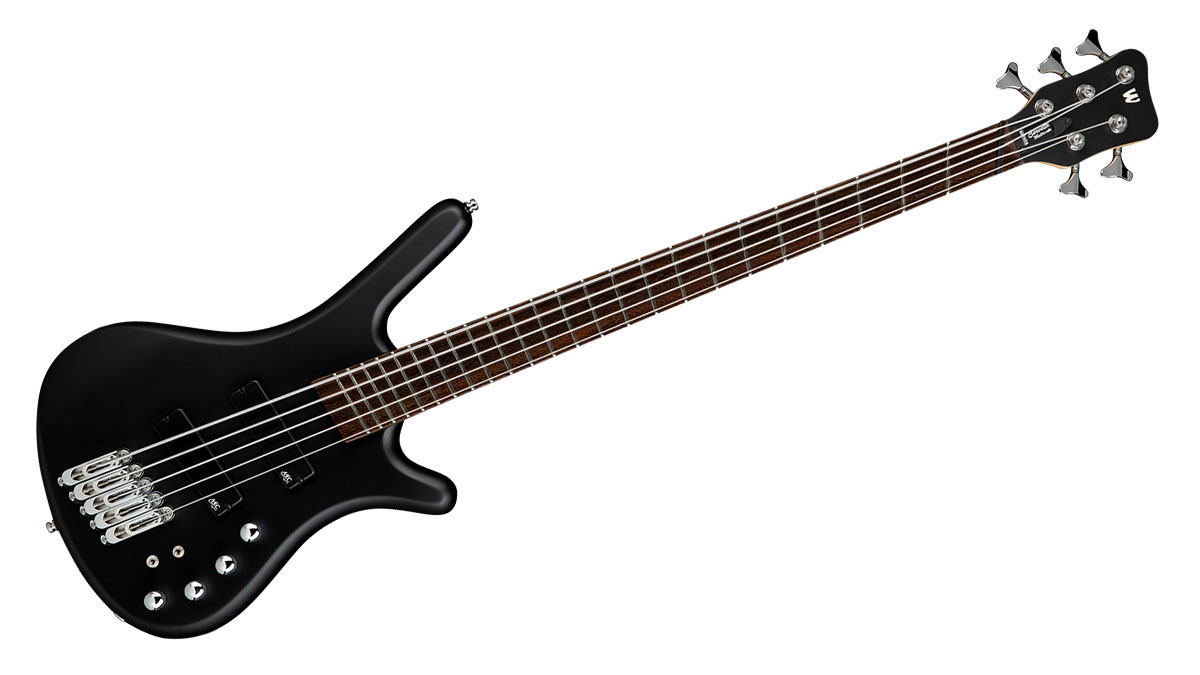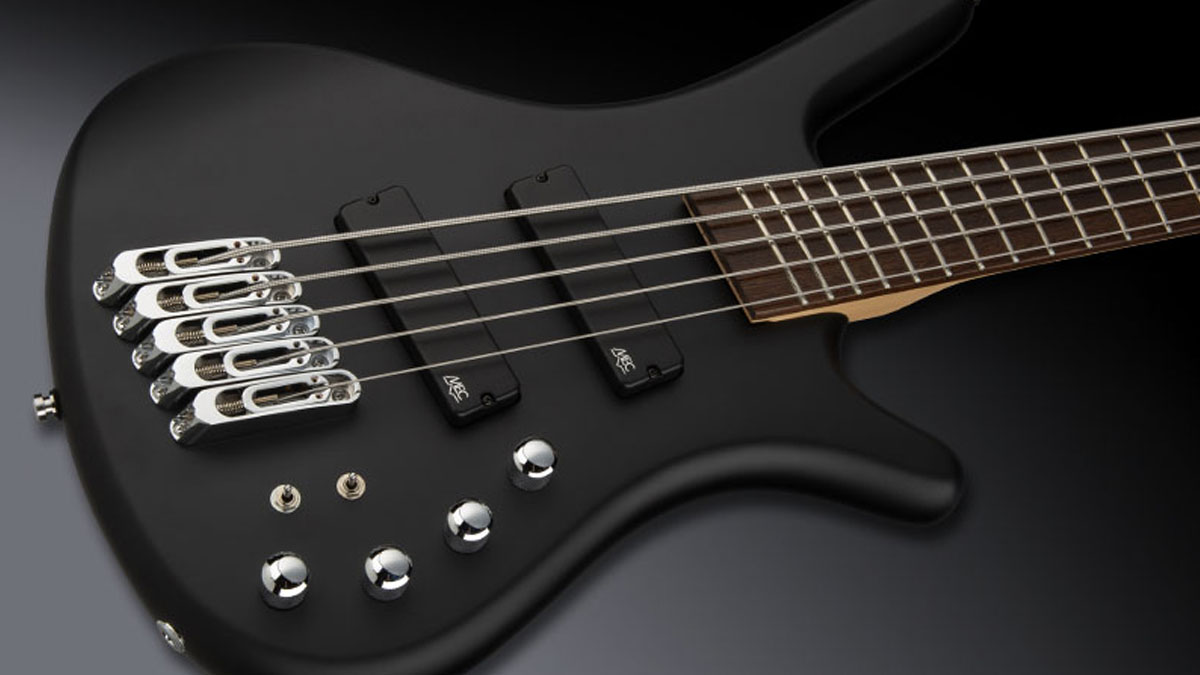Guitar World Verdict
An impressive entry into the multi-scale world from Warwick.
Pros
- +
Great tones.
- +
Superb build quality.
- +
Nice price.
Cons
- -
Nothing significant.
You can trust Guitar World
The Corvette RockBass Multiscale marks Warwick’s first foray into the world of fanned fret instruments. Elbowing its way into a marketplace that has exploded in popularity in recent years, Warwick’s China-built offering seems priced to appeal to the more budget-conscious low-ender.
With an enviable reputation for build quality, combined with one of the most impressive artist rosters in the business, Warwick could well be onto a winner if this bass guitaris any good. Let’s find out.
Build Quality
This new multi-scale instrument from Warwick has the recognizable body shaping associated with the long-established Corvette range. Topping a red alder body with a maple burl veneer front, the matt black finish of our review model is flawless, and is offset nicely by the chrome monorail bridge units, controls, and toggle switches.
The chunky MEC pickups look suitably businesslike, while the dot-free fingerboard and matching headstock complement the body nicely. Flipping the bass over, we note that the neck-to-body joint of the instrument features an additional stepped cutaway, presumably to allow for improved upper register access.
Access to the control cavity and battery is simple, thanks to an easily removed plastic cover plate: With no screws here, the plate has simple click tabs which can easily be opened without tools – simple, but very effective. The cavity itself is impeccably clean, with all of the wiring neatly bundled and cable-tied or shrink-wrapped.
The battery is secured with a metal clip, and the entire cavity is painted, with no excess sawdust present – a more common occurrence than you’d think. The neck is constructed from maple, with ekanga veneer strips, topped with a surprisingly glossy wenge fretboard. Fretwork is excellent across the board, and the instrument has arrived well set-up, ready to be played.

My only gripe in terms of the build is an aesthetic one: I found that the remaining triangle-shaped section of fingerboard behind the nut detracts somewhat from what is an otherwise sleek and attractive instrument.
Other multi-scale instruments – more expensive ones, granted – have an angled fretboard at the nut, with the headstock material angled to meet it accordingly. Presumably, addressing this minor visual quirk would increase the cost of the instrument disproportionately, taking it into a different sector of the market. As noted, this is a minor gripe, and one that I suspect is unlikely to bother most users.
Sounds and Playability
Contoured around the edges of the body, the instrument sits comfortably in the lap while seated, although there is some neck dive. This is less of an issue when standing, or using a strap, but nevertheless remains something to bear in mind. The neck profile is slimmer than I’ve come to expect from Warwick instruments, and is easy to get around.
The stepped cutaway at the heel does indeed improve upper register access to a degree, although I find the last two frets difficult to get to effectively – but how often do you really need them? It’s a common belief that multi-scale instruments are difficult to adapt to, but in my experience, this is not the case. I find the Corvette eminently playable, with no adaptation to fretting hand fingering technique required, even in the lower register.
With a 34” scale length for the G-string, widening to 35.5” for the low B-string, the string tension is perfect across the instrument, with the lowest string benefitting noticeably from the added scale length. Plugging in, the Corvette has a pleasing sonic palette, with notes in the lower register noticeably better defined than is sometimes the case.
Although the on-board EQ is a simple two-band affair, further tweaking is possible via the toggle switches, which allow for series/parallel/single coil configurations of the humbuckers. Grinding rock tones are easy to come by, as are more conventional options. Although a midrange control would have been nice, the options on offer here are more than enough for most modern players.

Conclusion
The Rockbass Corvette Multiscale is an impressive entry into the brave new-ish world of fanned fret instruments, and we’re confident that it will be a welcome addition to the lower-to-midrange portion of the market.
At this price, it’s by no means a budget instrument, but with multi-scale instruments often priced at considerably more, the Corvette is sure to be of interest to many young bass players. They’ll be getting plenty of bang for their buck, too: The instrument is superbly built, with a high level of attention to detail, and the tones on offer should satisfy all but the fussiest low-enders.
Shipping with a Rockbass gigbag, the Corvette Multiscale is a sensibly priced instrument from one of the biggest names in the business, making it a worthy contender for those looking for a fanned fret instrument.
Specs
- PRICE: $1,399 / £979
- MADE IN: China
- BODY: Red alder, maple burl veneer
- NECK: Maple with ekanga veneer stripes, 34” to 35.5” scale
- NECK JOIN: Bolt-on
- FRETBOARD: Wenge, graphite nut, 24 extra high jumbo nickelsilver frets
- PICKUP: 2 x passive MEC Soapbar pickups
- ELECTRONICS: Rockbass two-way
- CONTROLS: Volume, balance, treble, bass, two three-way miniswitches (series/parallel/single-coil)
- HARDWARE: Warwick tuners and bridge
- WEIGHT: 9 lbs
- GIGBAG/CASE: Gigbag
- LEFT-HAND AVAILABLE: No
- CONTACT: Warwick
“I used to weigh my guitars and use the heaviest one. As I’ve got older and my back’s got worse, lighter guitars are definitely better”: Lee Malia’s Jackson signature completes a full circle 20 years in the making – and it redefines what a Jackson can be
“It holds its own purely as a playable guitar. It’s really cool for the traveling musician – you can bring it on a flight and it fits beneath the seat”: Why Steve Stevens put his name to a foldable guitar










